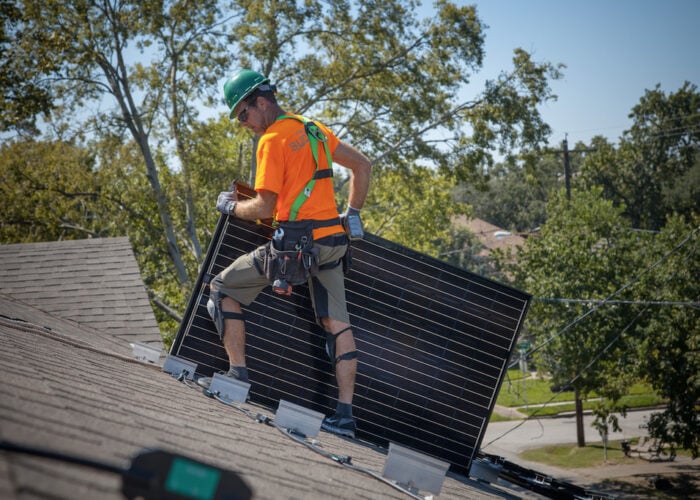Updated. Business conditions at LDK Solar have worsened considerably since reporting fourth quarter financial results at the end of April 2012. The integrated PV manufacturer has slashed both polysilicon production and full-year revenue guidance, while meeting the low mark of guided sales in its first quarter 2012 results.
LDK Solar had previously guided revenue in the range of US$2 billion to US$2.7 billion for 2012 but has significantly revised this downwards to between US$1.5 billion to US$2.0 billion.
Unlock unlimited access for 12 whole months of distinctive global analysis
Photovoltaics International is now included.
- Regular insight and analysis of the industry’s biggest developments
- In-depth interviews with the industry’s leading figures
- Unlimited digital access to the PV Tech Power journal catalogue
- Unlimited digital access to the Photovoltaics International journal catalogue
- Access to more than 1,000 technical papers
- Discounts on Solar Media’s portfolio of events, in-person and virtual
Polysilicon production has also been slashed from previous guidance of between 12,000 and 15,000 metric tons of which shipment to third-party customers were expected to be between 6,000 and 8,000MT to between 5,000 and 7,000MT of which shipments to third party customers are expected to be between 2,000MT and 3,000MT.
A key problem for LDK has been the continued price declines for polysilicon which have dropped to the low US$20/kg range, well below its production costs. In the fourth quarter, LDK reported its blended average polysilicon cost consumed was US$42.3 per kilogram.
During the fourth quarter, LDK Solar had also made an inventory write-down and provision for firm purchase commitment of US$232.6 million due to the declining market price for polysilicon as well as wafers and modules.
LDK reported it had produced 1,900.8MT of polysilicon during the first quarter of 2012, down from 2,317.8MT in the fourth quarter of 2011. Polysilicon inventory at the end of the fourth quarter was reported to be in the range of 2,492MT at an average cost of approximately US$30.3/kg.
Due to reporting first quarter results near the end of the second quarter, LDK’s projected polysilicon production guidance coupled to potential inventory levels could already have been reached in the second quarter. The company guided in-house polysilicon production for the second quarter of 2012 of only between 520MT and 570MT.
With polysilicon production costs significantly higher than spot market prices and above the average for long-term supply agreements, the shut-down of virtually all production to preserve cash and cut losses has either already happened or is imminent.
First quarter financials
LDK Solar reported first quarter 2012 sales of US$200.1 million, exceeding the low mark of previous guidance of between US$190 million to US$230 million.
Gross loss was US$131.0 million, compared to gross loss of US$275.2 million in the fourth quarter of 2011. Gross loss for the quarter was US$131.0 million, compared to gross loss of US$275.2 million in the fourth quarter of fiscal 2011. Net loss available to LDK Solar's shareholders was US$185.2 million, compared to a net loss of $588.7 million in the prior quarter.
LDK Solar said it ended the first quarter with US$135.7 million in cash and cash equivalents and US$603.3 million in short-term pledged bank deposits.
The company said it shipped 164.4MW of wafers in the first quarter, 153.9MW of cells and modules. LDK said it produced a total of approximately 51.2MW of cells during the first quarter.
Guidance
The company said in a statement that it expected revenue to be in the range of US$220 million to US$270 million in the second quarter.
Wafer shipments were guided to be between 300MW and 350MW, cells and module shipments between 140MW and 180MW, in-house polysilicon production between 520MT and 570MT and in-house cell production between 80MW and 100MW.
LDK Solar also made significant revisions to its full-year revenue guidance, down from US$2 billion to US$2.7 billion to between US$1.5 billion to US$2.0 billion.
Wafer production is expected to be between 2.0GW and 2.5GW, of which shipments to third party customers are expected to be between 1.2GW and 1.5GW.
In-house cell production is expected to be between 0.7GW and 1.0GW and module production between 0.9GW and 1.2GW.
Solar cell and module shipments to third party customers were guided for the the full-year to be between 0.8GW and 1.0GW and inverter shipments between 200MW to 250MW.
LDK Solar expects PV system project construction to be in the range of 400MW to 600MW and to recognize between 270MW and 360MW through project sales and EPC services for third party customers.
“Our revenue was within the expected range as our results reflected first quarter seasonality and the continued difficult solar industry conditions,” stated Xiaofeng Peng, chairman and CEO of LDK Solar. “Industry-wide overcapacity continued and drove price declines across the entire solar supply chain, which significantly reduced our revenue and negatively impacted our margins.”
Update
During a conference call to discuss first quarter results management noted that due to low polysilicon production utilization rates the blended production cost was US$42/kg. Polysilicon inventory stood at approximately 2,526MT with a blended cost claimed to be US$24.9/kg. LDK Solar said that its nameplate production of polysilicon was 17,000MT.
In regards to the significant reduction in polysilicon production guided for the second quarter, management noted that the company was focusing on implementing cost reduction programs, previously highlighted as hydrochlorination of silicon tetrachloride plant upgrades and implementation with an emphasis on improving quality of its poly. Capex required for the upgrades was put at US$100 million.
As a result, management acknowledged that it would be talking with customers to reschedule poly shipments for later in the year due to the need to focus on cost and quality improvements.







